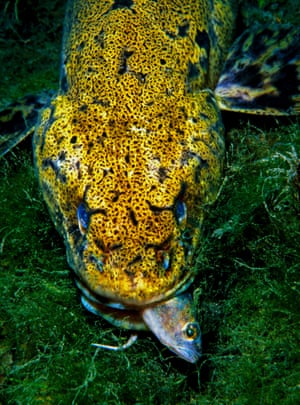Forget dreams of wolves, bears or lynx – the next animal to be restored to the British countryside could be a river bottom-dwelling fish that resembles a giant tadpole.
The burbot, much-maligned for its unprepossessing appearance with a fleshy appendage dangling from its chin, was last sighted in British rivers in 1969.
A reward for spotting it remains unclaimed and now a costed reintroduction plan is being drawn up for Natural England, the government’s conservation watchdog.
“The chance to bring back burbot to our rivers is hugely exciting,” said Jonah Tosney, operations director of the Norfolk Rivers Trust, which is masterminding the reintroduction plan. “Unlike beavers, lynx and sea eagles, they haven’t been gone for long; only about 50 years. Anglers still remember catching them. We’re hopeful that recent work to improve water quality and to restore habitat has brought our rivers back to a good enough state to support England’s great lost fish.”
The burbot, also known as the eelpout and the lingcod, disappeared at the same time as the otter vanished from waterways. In both cases, agricultural and heavy metal pollution may have played a role.
Tosney said the cause of the burbot’s disappearance remained “a bit of a mystery” but was a combination of pressures including the disappearance of natural “messy” edges to rivers, including pools, flooded areas and back channels.
“People did used to eat them but it’s more likely to be water quality and habitat quality slowly degrading since the second world war that caused their disappearance,” he said.
The burbot, the only freshwater species of cod, once thrived at the bottom of cool lowland rivers across eastern England but leaves its preferred habitat for ponds and pools to spawn and so requires pools and other freshwater close to the river.
Burbot could also be a beneficiary of beaver reintroductions, as the beavers create burbot-friendly habitat.
The fish has been successfully reintroduced into Belgium and Germany, and Tosney said there were several river valleys in the East Anglian Fens with good floodplains that could be ideal habitat.

Before the fish is brought back there will be further feasibility studies and also an environmental DNA survey to check there are no traces of burbot DNA in rivers, which would prove that a few survivors have evaded detection since the 1960s.
The Norfolk Rivers Trust hopes to raise GBP80,000 to fund a five-year reintroduction pilot. Because of the high mortality rate for young fish, hundreds of thousands of young burbot will be first reared in captivity from eggs brought from European hatcheries.
Dave Ottewell, a fish specialist for Natural England, said: “Over recent years great efforts have been made to restore our freshwater environment, rectifying some of the historic damage inflicted on these valuable and complex systems.
“This work has focused on rebuilding the natural processes that underpin high quality freshwater habitats. It is the successful restoration of these habitats that has led us to a position where we can now realistically look towards the reintroduction of this recently lost species back into its native range.”
The reintroduction may worry trout fishermen in particular because the omnivorous burbot will eat trout.
“They eat pretty much everything – invertebrates, other fish, and trout, no doubt about it, but trout will also eat burbot,” said Tosney. “Anglers do not like predators but I can’t see any other reason to object – it’s a native species, it should be here.”